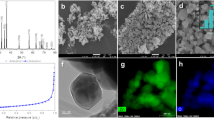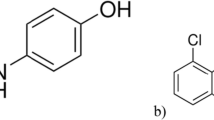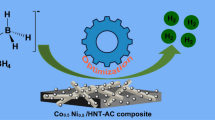Abstract
Phenol adsorption from aqueous solution was carried out using uncoated and methyl acrylic acid (MAA)-coated iron oxide nanoparticles (NPs), having size <10 nm, as adsorbents. Batch adsorption studies revealed that the phenol removal efficiency of MAA-coated NPs (950 mg g−1) is significantly higher than that of uncoated NPs (550 mg g−1) under neutral to acidic conditions. However, this improvement disappears above pH 9. The adsorption data under optimized conditions (pH 7) were modeled with pseudo-first- and pseudo-second-order kinetics and subjected to Freundlich and Langmuir isotherms. The analysis determined that pseudo-second-order kinetics and the Freundlich model are appropriate for both uncoated and MAA-coated NPs (all R 2 > 0.98). X-ray photoelectron spectroscopy analysis of pristine and phenol-adsorbed NPs revealed core-level binding energy and charge for Fe(2s) and O(1s) on the NP surfaces. The calculations suggest that phenol adsorption onto MAA-coated NPs is a charge transfer process, where the adsorbate (phenol) acts as an electron donor and the NP surface (Fe, O) as an electron acceptor. However, a physisorption process appears to be the relevant mechanism for uncoated NPs.






Similar content being viewed by others
References
Abdelwahab O, Amin NK (2013) Adsorption of phenol from aqueous solutions by Luffa cylindrica fibers: kinetics, isotherm and thermodynamic studies. Egypt J Aquat Res 39:215–223. doi:10.1016/j.ejar.2013.12.011
Ali G, Celal D, Basri SH, Mustafa S, Duygu O, Huseyin S (2012) Adsorption of phenol from aqueous solution on a low-cost activated carbon produced from tea industry waste: equilibrium, kinetic, and thermodynamic study. J Chem Eng Data 57:2733–2743
Amstad E, Gillich T, Bilecka I, Textor M, Reimhult E (2009) Ultrastable iron oxide nanoparticle colloidal suspensions using dispersants with catechol-derived anchor groups. Nano Lett 9:4042–4048. doi:10.1021/nl902212q
Banat FA, Al-Bashir B, Al-Asheh S, Hayajneh O (2000) Adsorption of phenol by bentonite. Environ Pollut 107:391–398. doi:10.1016/S0269-7491(99)00173-6
Bhattacharya A, Naiya T, Mandal S, Das S (2007) Adsorption, kinetics and equilibrium studies on removal of Cr(VI) from aqueous solutions using different low-cost adsorbents. Chem Eng J 137:529–541. doi:10.1016/j.cej.2007.05.021
de Jong BHWS, Ellerbroek D, Spek AL (1994) Low-temperature structure of lithium nesosilicate, Li4SiO4, and its Li1s and O1s X-ray photoelectron spectrum. Acta Crystallogr Sect B Struct Sci 50:511–518. doi:10.1107/S0108768194002375
Ding M, de Jong BHWS, Roosendaal SJ, Vredenberg A (2000) XPS studies on the electronic structure of bonding between solid and solutes: adsorption of arsenate, chromate, phosphate, Pb2+, and Zn2+ ions on amorphous black ferric oxyhydroxide. Geochim Cosmochim Acta 64:1209–1219. doi:10.1016/S0016-7037(99)00386-5
Dursun G, Ciçek H, Dursun AY (2005) Adsorption of phenol from aqueous solution by using carbonised beet pulp. J Hazard Mater 125:175–182. doi:10.1016/j.jhazmat.2005.05.023
Fang HHP, Chan OC (1997) Toxicity of phenol towards anaerobic biogranules. Water Res 31:2229–2242. doi:10.1016/S0043-1354(97)00069-9
Franz M, Arafat HA, Pinto NG (2000) Effect of chemical surface heterogeneity on the adsorption mechanism of dissolved aromatics on activated carbon. Carbon 38:1807–1819. doi:10.1016/S0008-6223(00)00012-9
Fresnais J, Yan M, Courtois J, Bostelmann T, Bée A, Berret J-F (2013) Poly (acrylic acid)-coated iron oxide nanoparticles: quantitative evaluation of the coating properties and applications for the removal of a pollutant dye. J Colloid Interface Sci 395:24–30. doi:10.1016/j.jcis.2012.12.011
Girginova PI, Daniel-da-Silva AL, Lopes CB, Figueira P, Otero M, Amaral VS, Pereira E, Trindade T (2010) Silica coated magnetite particles for magnetic removal of Hg2+ from water. J Colloid Interface Sci 345:234–240. doi:10.1016/j.jcis.2010.01.087
Gupta VK, Agarwal S, Saleh TA (2011) Chromium removal by combining the magnetic properties of iron oxide with adsorption properties of carbon nanotubes. Water Res 45:2207–2212. doi:10.1016/j.watres.2011.01.012
Hu H, Wang Z, Pan L (2010) Synthesis of monodisperse Fe3O4@silica core-shell microspheres and their application for removal of heavy metal ions from water. J Alloys Compd 492:656–661. doi:10.1016/j.jallcom.2009.11.204
Kim DH, Lee SK, Chun BY, Lee DH, Hong SC, Jang BK (1994) Illness associated with contamination of drinking water supplies with phenol. J Korean Med Sci 9:218–223. doi:10.3346/jkms.1994.9.3.218
Kim H, Lee M-E, Kang S, Chung J-W (2013) Thermodynamic analysis of phenol adsorption by powdered activated carbon. J Korean Soc Environ Eng 35:220–225. doi:10.4491/KSEE.2013.35.3.220
Liu J, Zhao Z, Jiang G (2008) Coating Fe3O4 magnetic nanoparticles with humic acid for high efficient removal of heavy metals in water. Environ Sci Technol 42:6949–6954. doi:10.1021/es800924c
Ma Y, Gao N, Chu W, Li C (2013) Removal of phenol by powdered activated carbon adsorption. Front Environ Sci Eng 7:158–165. doi:10.1007/s11783-012-0479-7
Malihe KS, Syed WH, Mohammad ST, Ali M, Parviz AA (2014) Magnetite molecularly imprinted nanoparticles for selective detection of phenol in wastewater samples followed by high performance liquid chromatography. Indian J Sci Res 5:362–368
Rafatullah M, Sulaiman O, Hashim R, Ahmad A (2010) Adsorption of methylene blue on low-cost adsorbents: a review. J Hazard Mater 177:70–80. doi:10.1016/j.jhazmat.2009.12.047
Salame II, Bandosz TJ (2003) Role of surface chemistry in adsorption of phenol on activated carbons. J Colloid Interface Sci 264:307–312. doi:10.1016/S0021-9797(03)00420-X
Terzyk AP (2003) Further insights into the role of carbon surface functionalities in the mechanism of phenol adsorption. J Colloid Interface Sci 268:301–329. doi:10.1016/S0021-9797(03)00690-8
Vázquez I, Rodríguez-Iglesias J, Marañón E, Castrillón L, Alvarez M (2007) Removal of residual phenols from coke wastewater by adsorption. J Hazard Mater 147:395–400. doi:10.1016/j.jhazmat.2007.01.019
Xu P, Zeng GM, Huang DL, Feng CL, Hu S, Zhao MH, Lai C, Wei Z, Huang C, Xie GX, Liu ZF (2012) Use of iron oxide nanomaterials in wastewater treatment: a review. Sci Total Environ 424:1–10. doi:10.1016/j.scitotenv.2012.02.023
Yoon SU, Mahanty B, Kim C-GG (2016) Preparation of superparamagnetic iron oxide nanoparticles and evaluation of their adsorption capacity toward carbamazepine and diatrizoate. Desalin Water Treat 57:7789–7800
Yu S, Chow GM (2004) Carboxyl group (–CO2H) functionalized ferrimagnetic iron oxide nanoparticles for potential bio-applications. J Mater Chem 14:2781–2786. doi:10.1039/b404964k
Zhang S, Niu H, Hu Z, Cai Y, Shi Y (2010) Preparation of carbon coated Fe3O4 nanoparticles and their application for solid-phase extraction of polycyclic aromatic hydrocarbons from environmental water samples. J Chromatogr A 1217:4757–4764. doi:10.1016/j.chroma.2010.05.035
Zhang Y, Xu S, Luo Y, Pan S, Ding H, Li G (2011) Synthesis of mesoporous carbon capsules encapsulated with magnetite nanoparticles and their application in wastewater treatment. J Mater Chem 21:3664–3671. doi:10.1039/c0jm03727c
Acknowledgments
This work was supported by a grant from “The GAIA Project” funded by the Ministry of Environment, Korea (2014000550004).
Author information
Authors and Affiliations
Corresponding author
Rights and permissions
About this article
Cite this article
Yoon, S.U., Mahanty, B., Ha, H.M. et al. Phenol adsorption on surface-functionalized iron oxide nanoparticles: modeling of the kinetics, isotherm, and mechanism. J Nanopart Res 18, 170 (2016). https://doi.org/10.1007/s11051-016-3478-y
Received:
Accepted:
Published:
DOI: https://doi.org/10.1007/s11051-016-3478-y




